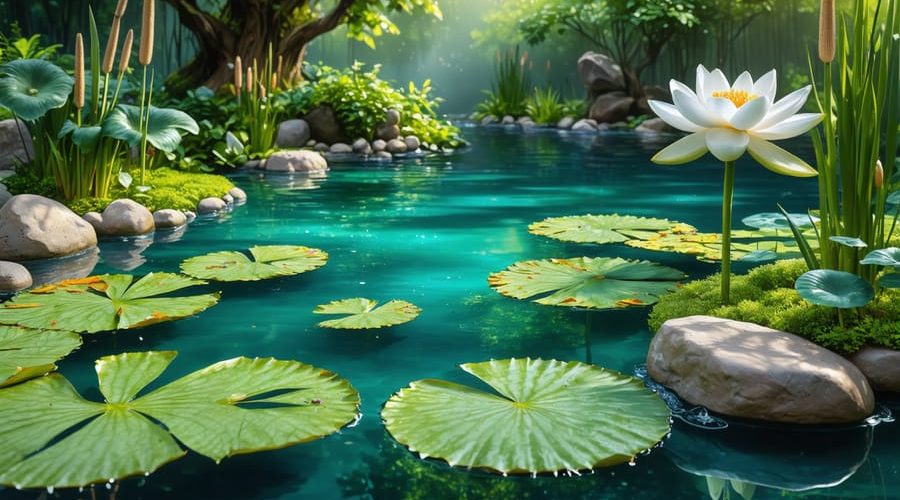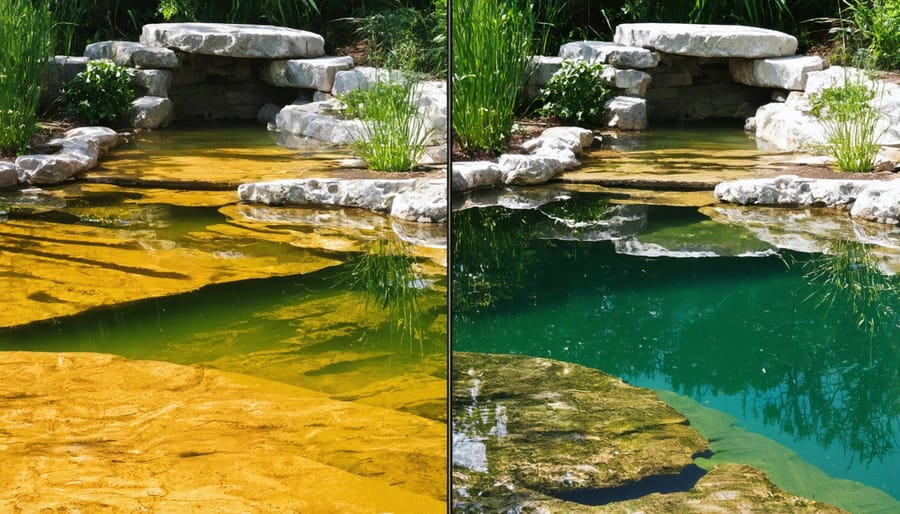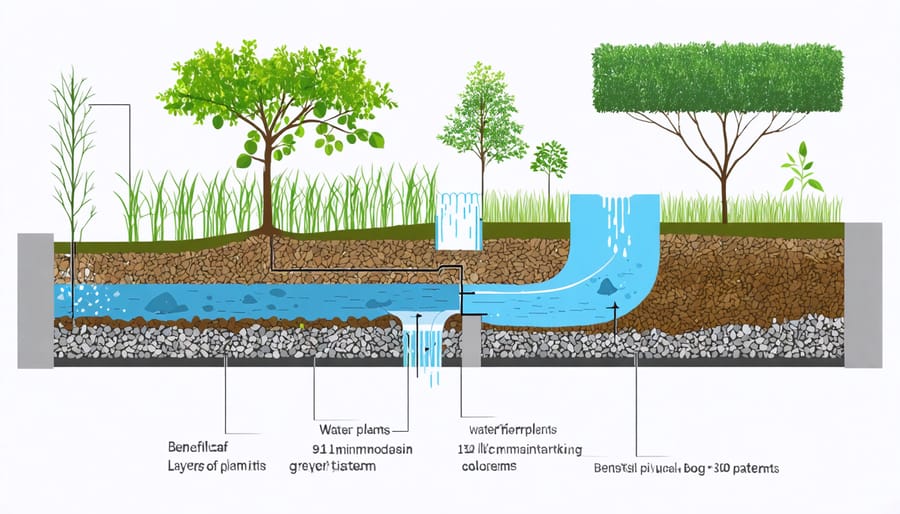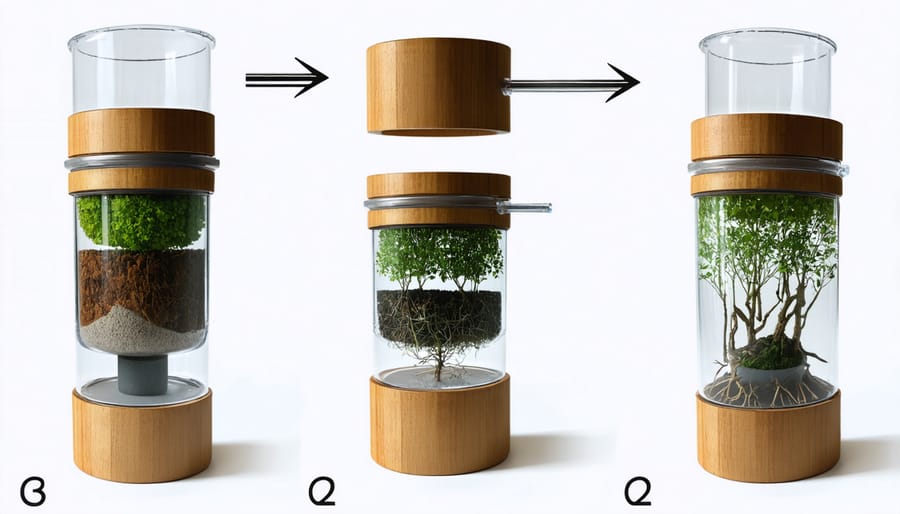
Natural Pond Filtration That Keeps Water Crystal Clear (Without Harsh Chemicals)
Transform your pond into a self-sustaining ecosystem by harnessing the power of natural filtration. Sustainable water filtration doesn’t just protect our environment—it creates healthier, clearer water while reducing maintenance costs and chemical dependencies. By combining beneficial bacteria, aquatic plants, and natural filter media like lava rock and coconut fiber, pond owners can establish a balanced ecosystem that maintains itself. Traditional chemical-based systems often disrupt natural cycles and harm beneficial organisms, while eco-friendly filtration works with nature to achieve crystal-clear results. Whether you’re maintaining a small garden pond or a large water feature, natural filtration methods offer a proven solution that’s both environmentally responsible and surprisingly effective.
The best part? These sustainable systems typically require less maintenance, consume less energy, and create a more resilient aquatic environment that supports diverse wildlife. As more pond owners discover the advantages of going green, eco-friendly filtration has evolved from a niche approach to the gold standard in water management. Let’s explore how you can implement these natural solutions in your own water feature, creating a cleaner, healthier environment for both aquatic life and future generations.
Why Traditional Filters Fall Short

The Hidden Costs of Chemical Filtration
While chemical filtration might seem like a quick fix for pond water problems, it often comes with significant hidden costs – both to your wallet and the environment. Regular purchases of chemical filters and treatments can add up quickly, sometimes costing hundreds of dollars annually. More concerning is the environmental impact: used chemical cartridges contribute to landfill waste, while the chemicals themselves can harm beneficial bacteria and disrupt your pond’s natural ecosystem.
These treatments can also create a dependency cycle. As chemical filters eliminate both harmful and beneficial organisms, your pond becomes reliant on continued chemical treatment to maintain water quality. This disrupts the natural biological processes that would otherwise help keep your water clean for free.
Additionally, some chemical filtration methods can be harsh on fish and plants, potentially causing stress or health issues over time. The residual chemicals might also seep into groundwater or affect local wildlife that visits your pond. By switching to eco-friendly filtration methods, you can break free from this costly cycle while creating a more sustainable and balanced aquatic environment.
Nature-Inspired Filtration Solutions
Plant-Based Filtering Systems
Nature’s own filtering system can be truly remarkable, and aquatic plants are the stars of the show when it comes to natural water purification. These living filters not only add beauty to your pond or water feature but also work tirelessly to keep your water crystal clear.
Water lilies, lotus, and floating plants like duckweed act as natural sunshades, preventing excessive algae growth by limiting sunlight penetration. Below the surface, submerged plants like hornwort and anacharis absorb excess nutrients that would otherwise feed unwanted algae, while their leaves provide valuable surface area for beneficial bacteria to colonize.
Marginal plants such as cattails, iris, and rushes are particularly effective at removing pollutants through their root systems. These plants thrive in the shallow edges of ponds, creating a natural transition zone that filters water as it enters your pond from surrounding areas.
For the best results, aim to cover about 60% of your pond’s surface with a combination of these plants. Start with just a few varieties and gradually add more as you learn what works best in your specific environment. Remember to regularly trim and maintain your aquatic plants to prevent overcrowding and ensure optimal filtering performance.
This living filtration system not only purifies your water naturally but also creates a thriving ecosystem that attracts beneficial wildlife like dragonflies and birds, making your water feature a vibrant part of your garden’s ecosystem.
Beneficial Bacteria: Your Silent Workers
Think of beneficial bacteria as your pond’s tiny housekeepers, working tirelessly to keep your water crystal clear. These microscopic helpers break down fish waste, fallen leaves, and other organic matter that would otherwise cloud your water and create unhealthy conditions.
In a natural filtration system, these bacteria form colonies in your filter media, plant roots, and even on rocks. There are two main types of beneficial bacteria at work: the first converts ammonia (from fish waste) into nitrites, while the second transforms these nitrites into less harmful nitrates that plants can use as fertilizer.
Creating a thriving bacterial colony is key to maintaining clear water, and it’s one of the most effective natural algae control methods. You can encourage beneficial bacteria growth by:
– Using porous filter media that provides plenty of surface area
– Maintaining consistent water flow
– Avoiding harsh chemicals that might harm bacterial colonies
– Keeping water temperature stable
– Adding bacterial supplements during system startup
Remember, establishing a healthy bacterial colony takes time – usually 4-6 weeks. Be patient and avoid the temptation to clean your filter media too thoroughly, as this could remove the beneficial bacteria you’re trying to cultivate.
Creating a Natural Filter bog
Creating a natural filter bog is a rewarding weekend project that can transform your pond’s water quality. Start by choosing a location near your pond that’s slightly elevated – this allows water to flow back into the pond naturally. You’ll need an area roughly 20-30% the size of your pond’s surface.
Begin by digging a shallow basin about 18-24 inches deep, with gently sloping sides. Line the area with high-quality pond liner, securing the edges well above water level. Add a layer of gravel at the bottom for drainage, followed by a mix of coarse and fine gravel layers.
Install a submersible pump in your pond and connect it to PVC piping that leads to your bog. Create a simple distribution system by drilling holes in the pipe to ensure even water flow throughout the bog area.
Now comes the fun part – planting! Choose a variety of native aquatic plants like rushes, iris, and cattails. These plants are natural filters that remove excess nutrients from the water. Plant them directly in the gravel, spacing them about 6-8 inches apart.
Connect your pump and watch as water slowly filters through the plant roots and gravel before returning to your pond. Within a few weeks, you’ll notice clearer water and healthier pond life. Remember to trim plants occasionally and remove any fallen leaves to maintain optimal filtration.

DIY Eco-Filter Setup
Materials and Construction
To build a natural pond filter, you’ll need readily available, eco-friendly materials that won’t harm your water ecosystem. Here’s what you’ll need:
Essential Materials:
– Food-grade plastic barrel or container (55-gallon recommended)
– Natural lava rock or crushed granite
– Activated charcoal (coconut-based)
– Natural filter media (rice husks, coconut fiber, or bamboo rings)
– Bio-balls made from recycled materials
– Untreated pine bark
– PVC pipes (minimum chemicals, locally sourced if possible)
– Natural cotton filter pad
Assembly Steps:
1. Clean your container thoroughly with natural soap and rinse well
2. Drill intake and outflow holes for the PVC pipes
3. Create layers starting from bottom to top:
– Large lava rock (bottom layer)
– Activated charcoal
– Bio-balls
– Natural filter media
– Pine bark
– Cotton filter pad (top layer)
Pro tip: Arrange materials from coarse to fine as water flows upward. This creates optimal filtration while allowing beneficial bacteria to thrive. When sourcing materials, look for local suppliers and recycled options where possible. Many of these materials can be found at garden centers or even collected from nature (just ensure they’re clean and chemical-free).
Remember to rinse all materials thoroughly before assembly to remove any dust or debris. Your filter will become more effective over time as beneficial bacteria colonize the different layers.

Maintenance Made Simple
Maintaining a natural water filtration system doesn’t have to be complicated. With just a few simple routines, you can keep your eco-friendly system running smoothly throughout the year. The key is consistency and observation rather than intensive labor.
Start with a weekly visual check of your system. Look for any debris accumulation around plant roots and filter media. Gently remove larger pieces of debris like fallen leaves or twigs by hand or with a net. This quick task prevents organic matter from overwhelming your system.
Monthly maintenance should include rinsing your biological filter media in pond water – never tap water, as this preserves beneficial bacteria. Trim any dead or yellowing plant matter from your aquatic plants, and check that water flow remains steady through all parts of your system.
Seasonal care is crucial for long-term success. In spring, divide and replant overgrown aquatic plants to maintain optimal filtering capacity. Summer calls for monitoring water levels and topping up with rainwater when possible. Fall requires more frequent debris removal as leaves drop, while winter maintenance focuses on preventing freezing in colder climates.
Keep a simple maintenance log to track your system’s performance. Note any changes in water clarity, plant health, or flow rates. This helps you spot potential issues before they become problems and adjust your routine accordingly.
Remember, natural filtration systems become more efficient over time as beneficial bacteria colonies establish themselves. Your maintenance needs may actually decrease as your system matures, making this eco-friendly choice even more rewarding in the long run.
Troubleshooting Common Issues
Even the most well-designed eco-friendly filtration systems can encounter occasional hiccups. The good news is that most common issues have simple solutions that don’t require harsh chemicals or expensive fixes. Here’s how to tackle the most frequent challenges:
Cloudy or Green Water
If your water becomes cloudy or develops a green tinge, you’re likely dealing with an algae bloom. Before reaching for chemical solutions, try adding more floating plants to reduce sunlight penetration. You can also check if your biological filtration needs cleaning or if you need to adjust your pump flow to better maintain perfect water balance.
Poor Water Flow
When water flow seems reduced, first check for debris blocking your pump intake. Clean any accumulated leaves or plant matter. If the problem persists, inspect your filter media for compaction and rinse it gently in pond water to preserve beneficial bacteria.
Unpleasant Odors
Bad smells often indicate excess organic matter decomposition. Remove fallen leaves promptly, trim dead plant material, and ensure your system isn’t overloaded. Consider adding beneficial bacteria supplements to boost natural decomposition.
Filter Media Breaking Down
Natural filter materials like coconut fiber or barley straw will eventually decompose. Plan to replace these materials seasonally, and always overlap new and old media to maintain bacterial colonies.
Inadequate Filtration
If your system seems overwhelmed, you might need to reduce fish stock or increase plant coverage. Remember that natural systems work best when not pushed to their limits. Start small and gradually increase bioload as the ecosystem establishes itself.
By addressing these issues promptly and maintaining regular cleaning schedules, you’ll keep your eco-friendly filtration system running smoothly while preserving its natural balance.
Making the switch to eco-friendly water filtration isn’t just good for the environment – it’s a smart choice for your wallet and your water quality. By embracing natural filtration methods, you’re reducing plastic waste from disposable filters, eliminating harmful chemicals, and creating a sustainable system that works in harmony with nature.
Remember that every small step counts. Whether you start with adding aquatic plants to your pond, setting up a simple gravel filter, or going all-in with a complete natural filtration system, you’re contributing to a healthier ecosystem. The initial setup might take a bit more planning, but the long-term benefits are worth it: lower maintenance costs, reduced energy consumption, and crystal-clear water that’s safe for both wildlife and humans.
Don’t be afraid to experiment and find what works best for your specific needs. Start small, learn from experience, and gradually expand your eco-friendly filtration system. Your pond will thank you with thriving plants, happy fish, and a beautiful, sustainable water feature that you can enjoy for years to come. Make the change today – it’s easier than you think, and the planet will thank you for it!
